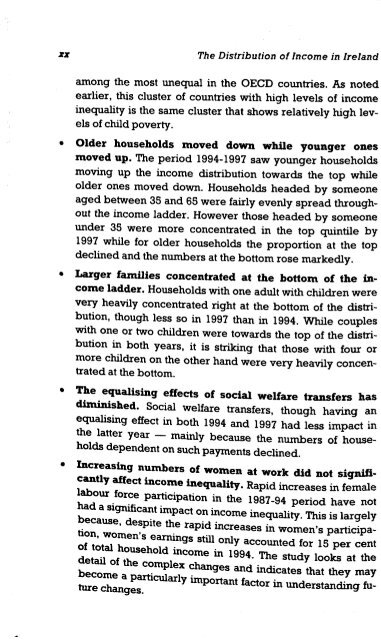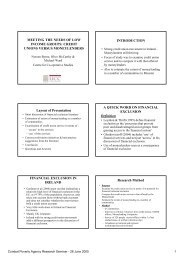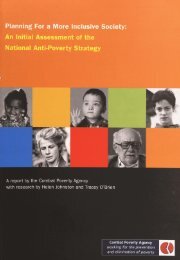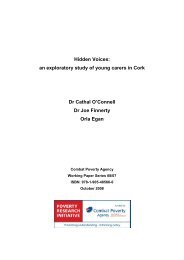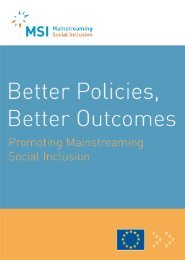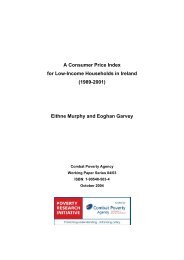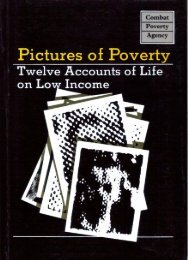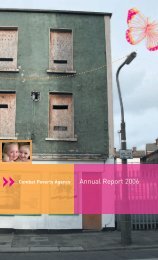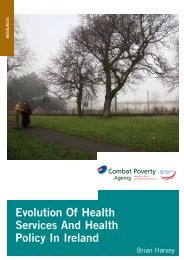The Distribution of Income in Ireland (2000) - Combat Poverty Agency
The Distribution of Income in Ireland (2000) - Combat Poverty Agency
The Distribution of Income in Ireland (2000) - Combat Poverty Agency
- No tags were found...
You also want an ePaper? Increase the reach of your titles
YUMPU automatically turns print PDFs into web optimized ePapers that Google loves.
XX<strong>The</strong> <strong>Distribution</strong> <strong>of</strong> <strong>Income</strong> <strong>in</strong> <strong>Ireland</strong>Forewordxxiamong the most unequal <strong>in</strong> the OECD countries. As notedearlier, this cluster <strong>of</strong> countries with high levels <strong>of</strong> <strong>in</strong>come<strong>in</strong>equality is the same cluster that shows relatively high levels<strong>of</strong> child poverty.Older households moved down while younger onesmoved up. <strong>The</strong> period 1994-1997 saw younger householdsmov<strong>in</strong>g up the <strong>in</strong>come distribution towards the top whileolder ones moved down. Households headed by someoneaged between 35 and 65 were fairly evenly spread throughoutthe <strong>in</strong>come ladder. However those headed by someoneunder 35 were more concentrated <strong>in</strong> the top qu<strong>in</strong>tile by1997 while for older households the proportion at the topdecl<strong>in</strong>ed and the numbers at the bottom rose markedly.Larger families concentrated at the bottom <strong>of</strong> the <strong>in</strong>comeladder. Households with one adult with children werevery heavily concentrated right at the bottom <strong>of</strong> the distribution,though less so <strong>in</strong> 1997 than <strong>in</strong> 1994. While coupleswith one or two children were towards the top <strong>of</strong> the distribution<strong>in</strong> both years, it is strik<strong>in</strong>g that those with four ormore children on the other hand were very heavily concentratedat the bottom.<strong>The</strong> equalis<strong>in</strong>g effects <strong>of</strong> social welfare transfers hasdim<strong>in</strong>ished. Social welfare transfers, though hav<strong>in</strong>g anequalis<strong>in</strong>g effect <strong>in</strong> both 1994 and 1997 had less impact <strong>in</strong>the latter year - ma<strong>in</strong>ly because the numbers <strong>of</strong> householdsdependent on such payments decl<strong>in</strong>ed.^creas<strong>in</strong>g numbers <strong>of</strong> women at work did not significantlyaffect <strong>in</strong>come <strong>in</strong>equality. Rapid <strong>in</strong>creases <strong>in</strong> femalelabour force participation <strong>in</strong> the 1987-94 period have notbecausf^^ mPaCX ° n <strong>in</strong>C ° me ^q^ity- This is largelytaPid lnCreaSes <strong>in</strong>Sn wo m ^ 2wome *'* Participa<strong>of</strong>^otlhoT 'nT" 9 " Stm 0nly accounted fo * 15 Per centde S <strong>of</strong> Z!, mC ° me * 1994 - e s ? *"* ^ thebecl.e a ^TT " ^ ^ "* mdicates ** they mayZ*Z: g lT * "*"*"faCt ° r * -^stand<strong>in</strong>g Z• Overall <strong>in</strong>come <strong>in</strong>equality has fallen s<strong>in</strong>ce 1973. Look<strong>in</strong>gback over a longer period, from 1973-1987 <strong>in</strong>equality <strong>in</strong> thedistribution <strong>of</strong> household <strong>in</strong>come fell markedly, with theshare <strong>of</strong> the top decile down by 1.4 per cent <strong>of</strong> total <strong>in</strong>comeand that <strong>of</strong> the bottom qu<strong>in</strong>tile up by 0.9 per cent. This reflectsthe <strong>in</strong>creas<strong>in</strong>gly redistributive impact <strong>of</strong> <strong>in</strong>come taxand a substantial <strong>in</strong>crease <strong>in</strong> the average tax rate. From 1987to 1994 this cont<strong>in</strong>ued at a much slower rate. However with<strong>in</strong>this overall statistic, between 1987 and 1994 wage <strong>in</strong>equality<strong>in</strong> <strong>Ireland</strong> <strong>in</strong>creased substantially, even though centralisedwage agreements were re<strong>in</strong>troduced <strong>in</strong> 1987 and have hada significant impact on improv<strong>in</strong>g the economic landscape.UNDERSTANDING THE FINDINGS<strong>The</strong> wider economic context for this report is one <strong>in</strong> which ourwealth is clearly ris<strong>in</strong>g, with more people at work, an <strong>in</strong>crease<strong>in</strong> the real <strong>in</strong>comes <strong>of</strong> the poor and a drop <strong>in</strong> long-term or consistentpoverty and child poverty. However, relative <strong>in</strong>comepoverty has <strong>in</strong>creased, the depth <strong>of</strong> poverty is greater, the risk<strong>of</strong> poverty for some groups is <strong>in</strong>creas<strong>in</strong>g and a quarter <strong>of</strong> childrenlive <strong>in</strong> poor households.<strong>The</strong> key lesson from this research report is that <strong>in</strong> a fastgrow<strong>in</strong>g economy, a ris<strong>in</strong>g tide does not lift all boats equally.While more people are employed now than before, those at thetop <strong>of</strong> the <strong>in</strong>come ladder have benefited at a faster pace thanthose at the bottom. It is also clear that <strong>in</strong>ternationally <strong>Ireland</strong>fares badly on the <strong>in</strong>come <strong>in</strong>equality front, and that despite undoubtedadvances <strong>in</strong> our general prosperity and availability <strong>of</strong>employment, we are still lagg<strong>in</strong>g well beh<strong>in</strong>d the levels <strong>of</strong> <strong>in</strong>comeequality that have been achieved <strong>in</strong> other moderneconomies <strong>in</strong> Europe or other <strong>in</strong>dustrialised OECD countries.All <strong>of</strong> this raises questions about how progressive fiscal andwelfare policies can be developed to ensure that this period <strong>of</strong>resource buoyancy does not lead to a more divided and moreunequal society. <strong>The</strong> <strong>Combat</strong> <strong>Poverty</strong> <strong>Agency</strong> believes that it isthe responsibility <strong>of</strong> government to ensure that the <strong>in</strong>equalitiesaris<strong>in</strong>g from wealth creation are controlled and amelioratedthrough public pohcy <strong>in</strong>terventions. <strong>The</strong> challenge <strong>of</strong> good


